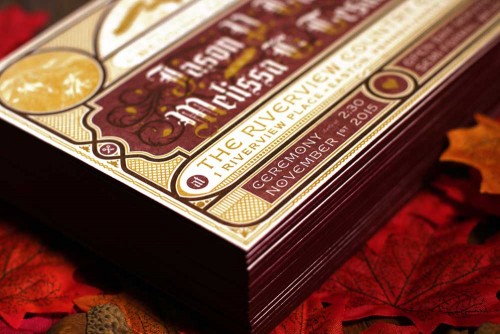You want people to take the time to engage with the stationery they receive from you. Whether it’s a wedding invitation, a business card, or a handwritten note, you give it to them hoping it gives them an opportunity to slow down for a second and reflect on the love you put into it (whether it’s personal or business, you should always be acting with love).
We believe one of the ways to give your recipients ample opportunity to slow down and engage with your stationery is to reward the careful observer. We like to hide things in plain view (and sometimes not so plain view) to allow your guests, friends, and contacts the opportunity to discover new things with each turn of your stationery.
An effective way to do this is to add edge-painting or edge-coloring to your stationery. Edge-painted invitations, business cards and stationery add an extra level of visual drama.
Edge-painting is just as it sounds: coloring the edges of your stationery with paint or ink.

In bulk (like a box of business cards), edge painting gives your stationery a wash of color where you’d normally see plain paper. Held individually, the subtlety of edge-painting increases stationery’s impact as the holder turns it in her hand. It’s a little moment of value-added delight.
Practically, there are a few things you can do with this added visual real estate:
- Reinforce your colors
The edges can be the perfect place to reinforce the colors or your brand or event. Repeating a color of the front on the side drives the colors home to the view. - Add a Pop to a monochromatic palette
If you’re printing with a complementary or monochromatic palette, this is a chance to add the visual surprise of an accent color. We love using bright colors on dark papers here, even if it diminishes the whole “subtlety” thing. - Disguise the ingredients
When duplexing and triplexing, edge-colors can hide the composition of your stationery. While there are plenty of times where this is great, we do love the idea of leaving the edge raw when appropriate. Sometimes showing that two- or three-color edge is a way to reveal the care that went into the process.
While edge-coloring is often associated with letterpress stationery, it’s not limited to it. We do suggest you invest in heavier stocks if you’re going to add edge-painting, as thinner stocks minimize your ability to see the effect – and we like things to be high-impact.
And edge-painting’s not limited to paper. When working in unconventional materials like wood or acrylic, edge-painting can be a powerful finishing technique.
As with many of the processes we employ, Edge-painting has its own unique properties. We find acrylic paint is usually the best fit tool for the job. That means that it reflects light differently than the inks we use. The result is that painted edges usually won’t look exactly like the colors on the front of the sheet. While this does nothing to minimize the effectiveness of edge-painting, it’s definitely something worth noting.
So, when you’re planning your next stationery project, consider edge-painting as a great way to keep eyes on your work of art a little longer.

0 Comments